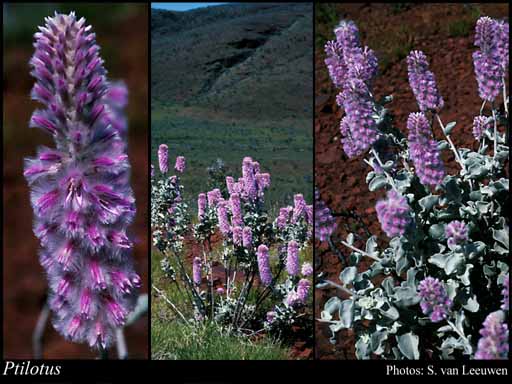- Reference
- Prodr.Fl.Nov.Holland. 415 (1810)
- Name Status
- Current

Scientific Description
Family Amaranthaceae.
Habit and leaf form. Small shrubs, or herbs. Annual to perennial. Leaves cauline, or basal and cauline. Plants with a basal concentration of leaves (sometimes), or with neither basal nor terminal concentrations of leaves. Leaves alternate; non-sheathing; simple; epulvinate. Leaf blades entire; one-veined, or pinnately veined. Leaves without stipules. Leaf blade margins entire (often undulate). Stem anatomy. Nodes unilacunar. Secondary thickening developing from a conventional cambial ring, or anomalous.
Reproductive type, pollination. Fertile flowers hermaphrodite. Unisexual flowers absent. Plants hermaphrodite.
Inflorescence and flower features. Flowers aggregated in ‘inflorescences’; in racemes (strictly), or in spikes, or in heads. The terminal inflorescence unit cymose. Inflorescences terminal, or axillary; dense, globular to cylindric head- or spike-like racemes (a spike in P. albidus), the axis usually woolly; with involucral bracts, or without involucral bracts; almost pseudanthial, or not pseudanthial. Flowers pedicellate, or sessile (rarely: in P. albidus); bracteate. Bracts persistent (scarious, ostensibly veinless or one-veined, acute to aristate). Flowers bracteolate. Bracteoles persistent (scarious, ostensibly veinless or one-veined, acute to aristate). Flowers small to medium-sized; regular, or regular to somewhat irregular, or somewhat irregular to very irregular. The floral asymmetry involving the perianth and involving the androecium, or involving the androecium (the three inner sepals sometimes smaller, the androecial members sometimes unequal, and the flowers sometimes curved). Flowers 5 merous; cyclic; tricyclic. Floral receptacle developing a gynophore, or with neither androphore nor gynophore. Free hypanthium sometimes present (dubiously, in that the staminal cup is sometimes ‘adnate to the base of the calyx’), or absent. Hypogynous disk absent. Perianth sepaline (dry and membranous); 5; 1 -whorled; basally joined, or free; usually more or less petaloid; hairy, or glabrous; green, or white, or cream, or red, or pink, or purple (in various combinations); persistent; accrescent, or non-accrescent. Calyx present (the perianth being thus interpreted); 5; 1 -whorled; basally gamosepalous, or polysepalous; when gamosepalous, deeply lobed. Calyx lobes when gamosepalous, markedly longer than the tube. Calyx hairy (usually, externally, internally or both), or glabrous; imbricate; regular to unequal but not bilabiate; green, or white, or cream, or red, or pink, or purple (in various combinations); non-fleshy; persistent (rigid); accrescent (sometimes), or non-accrescent; with the median member posterior. Sepals linear, or triangular, or elliptic. Calyx lobes linear, or triangular, or elliptic. Corolla absent. Androecial members definite in number. Androecium 5. Androecial sequence not determinable. Androecial members free of the perianth, or adnate (basally, to the perianth or ‘hypanthium’); all equal to markedly unequal; basally coherent; 1 - adelphous (the filaments connate basally into a membranous cup); 1 -whorled. Androecium exclusively of fertile stamens, or including staminodes (commonly with some members lacking anthers, and sometimes with ‘pseudostaminodial scales or hairs’ alternating with the true androecium). Staminodes when present, 1–3; when present, petaloid, or non-petaloid, or petaloid and non-petaloid. Stamens (1–)2–5; reduced in number relative to the adjacent perianth, or isomerous with the perianth; oppositisepalous. Anthers dorsifixed; dehiscing via longitudinal slits; introrse; bisporangiate, or tetrasporangiate. Pollen shed as single grains. Gynoecium 2–3 carpelled. The pistil 1 celled. Carpels reduced in number relative to the perianth. Gynoecium syncarpous (pseudomonomerous); eu-syncarpous; superior. Ovary unilocular; 1 locular; sessile to stipitate (glabrous or hairy). Gynoecium stylate. Styles 1; simple; attenuate from the ovary; apical, or lateral (i.e. central or excentric); about as long as the ovary at anthesis to much longer than the ovary at anthesis. Stigmas 1; 1 - lobed (entire); capitate; dry type; papillate; Group II type. Placentation basal. Ovules in the single cavity 1; pendulous; non-arillate; campylotropous.
Fruit and seed features. Fruit non-fleshy; indehiscent; capsular-indehiscent, or a nut (a utricle); 1 celled; 1 locular; 1 seeded. Seeds non-endospermic. Perisperm present. Seeds with starch. Embryo well differentiated. Cotyledons 2. Embryo curved. Testa smooth.
Geography, cytology, number of species. Native of Australia. Largely endemic to Australia (with one species extending to Indonesia). A genus of about 90 species; about 80 species in Western Australia.
Keys
Key to the Ptilotus of Western Australia
R. Davis
Taxonomic Literature
- Davis, Robert W.; Tauss, Catherine 2011. A new and rare species of Ptilotus (Amaranthaceae) from a suburban wetland of the eastern Swan Coastal Plain, Western Australia.
- Wheeler, Judy; Marchant, Neville; Lewington, Margaret; Graham, Lorraine 2002. Flora of the south west, Bunbury, Augusta, Denmark. Volume 2, dicotyledons. Australian Biological Resources Study.. Canberra..
- Grieve, B. J.; Blackall, W. E. 1998. How to know Western Australian wildflowers : a key to the flora of the extratropical regions of Western Australia. Part II, Dicotyledons (Amaranthaceae to Lythraceae). University of W.A. Press.. Nedlands, W.A..
- Wheeler, J. R.; Rye, B. L.; Koch, B. L.; Wilson, A. J. G.; Western Australian Herbarium 1992. Flora of the Kimberley region. Western Australian Herbarium.. Como, W.A..
- Benl, G. 1988. Ptilotus crispus, a new species of Amaranthaceae in the Kimberley division of Western Australia.
- Marchant, N. G.; Wheeler, J. R.; Rye, B. L.; Bennett, E. M.; Lander, N. S.; Macfarlane, T. D.; Western Australian Herbarium 1987. Flora of the Perth region. Part one. Western Australian Herbarium.. [Perth]..
- Benl, G. 1983. Taxonomic studies on Ptilotus R.Br. (Amaranthaceae) in Western Australia.
- Benl, G. 1980. Five new taxa of Ptilotus (Amaranthaceae) from Western Australia.